Abstract
This study performed an experimental exploration to analyze the influence of different grain sizes of coal on the nanostructure and morphological parameters of soot generated during combustion. Initially, primary and mature soot samples were gained from the combustion flames of two different grain sizes of coal (less than 150 μm, named sample #1, and 6–8 mm, named sample #2) by using thermophoresis sampling technology. Subsequently, the transmission electron microscopy (TEM) and scanning electron microscopy (SEM) were employed to investigate and analyze the soot samples, with the aim of obtaining their morphological parameters and nanostructure characteristics. The TEM images indicate that the nascent soot produced during the flame formed by small-sized coal is relatively uniform, with individual particles 8–14 nm in size. The grain size of the nascent soot produced by large-sized coal is much larger, within a wide range of 50–350 nm. Additionally, the nanostructures of the nascent soot particles produced by samples #1 and #2 mainly consist of upright parallel crystal stripes. The crystal stripes of the soot particles formed by sample #1 have obvious microcrystalline structures, whereas only a small amount of microcrystalline structure is found at the edge of sample #2. Compared with sample #2, the soot formed during the combustion of sample #1 exhibits a denser crystalline structure. The SEM results indicate that the mature soot agglomerates formed in sample #2 are larger and more in quantity compared to sample #1. Furthermore, the mature soot agglomerates formed in sample #2 have a stronger coagulation performance and a more compact structure than that formed in sample #1.
1. Introduction
Coal is one of the primary energy sources worldwide, particularly in power generation and industrial processes. However, it serves as a significant contributor to the generation of air pollutants, emitting various pollutants including atmospheric particulates (Soot), sulfur dioxide (SO2), nitrogen oxides (NOx), and carbon dioxide (CO2) [1]. Among these pollutants, soot is usually an important particulate matter (PM) commonly formed from solid fuels during pyrolysis and incomplete combustion [2,3,4,5]. As an important component of ultrafine PM, soot usually has a rather small particle size (less than 1 μm) and a large specific surface area, and thus is prone to enriching harmful substances [6,7,8]. There are significant health and environmental impacts due to its adverse effects on respiratory health, atmospheric visibility, and climate. Accordingly, it is essential to comprehend the formation mechanism and physicochemical properties of soot in a pulverized coal flame for the purpose of advancing the clean and efficient utilization of coal.
The formation of soot is a very complex process of transforming physicochemical properties, and the process of the soot formation mechanism is influenced by various factors, such as the composition and types of solid fuel [9,10], temperature [11], pressure, moisture content, etc. Han et al. [12] investigated the different formation mechanisms of PAHs during the combustion of solid fuels at different temperatures, and the results showed that the synthesis of PAHs is the main process during wood combustion and, during coal combustion, the pyrolysis of the supramolecular structure of coal is the main formation pathway of PAHs. In addition, the grain size of pulverized coal directly affects its combustion flame characteristics and then affects the formation process and mechanism of soot, thus changing the morphological characteristics of soot. Jiang et al. [13] found that as the coal grain size decreased, the activation energy of combustion in the high- and low-temperature ranges decreased and the decomposition of the TG curve of coal combustion became more obvious. Zhang et al. [14] found that the decrease in the grain size of low-rank coal can increase its combustibility by focusing on the influence of a low-rank coal grain size on the combustion characteristics. Due to the different heat and mass transfer processes, the apparent activation energy of coal decreases with the increase in volatile content and grain size. Cong et al. [15] investigated the combustion properties of coal samples of varying particle sizes by using a thermogravimetric analyzer and found that the ignition and burnout temperatures of coal increased linearly with the increase in grain size. Other studies have also shown that the grain size of coal can change the combustion characteristics [16,17,18] and that the physical structure and combustion properties of coal are improved with the decrease in grain size [19,20]. In addition, numerous studies have shown that changes in the combustion characteristics of fuels can further alter the mechanisms involved in the formation of soot and its physicochemical properties. Du et al. [21] reported that soot production was inhibited with increasing flame height. Through the experimental investigations into the impact of pyrolysis conditions on soot generation [2,22], it has been shown that the relationship between the total soot production and coal type depends on the amount of tar produced by coal pyrolysis. Moghiman et al. studied the effects of two combustion models on flame structure and soot generation and found that soot generation is significantly affected by both the equivalence ratio as well as the temperature of inlet air [23]. Lou et al. [24] explored the effects of the chemical equivalence mixing fraction and the temperature of the flame on the generation characteristics of soot in laminar diffusion flames by altering the fuel dilution and oxygen concentration. The numerical findings suggested that both soot generation and its oxidation were significantly enhanced, with the influence of the temperature increase on surface growth being more pronounced than that on oxidation mechanisms, resulting in an augmented concentration of soot particulates. Guo et al. [20] conducted an investigation into the effects of combustion characteristics and flame morphology on the soot formation in reverse flow diffusion flames utilizing ethylene as a fuel based on detailed chemical mechanisms. They found that the stoichiometric mixing ratio increased and the flame structure underwent significant changes, resulting in a decrease in the amount of soot in the flame. In industrial applications, in order to achieve optimal combustion performance, the size of pulverized coal particles must be carefully considered and matched to the specific combustion system and application, and, in many cases, combustion preparation techniques, such as milling or pulverizing, can be used to control the particle size distribution and improve combustion efficiency and environmental performance. Overall, understanding the effect of the pulverized coal particle size on combustion performance is critical to optimizing combustion processes and reducing emissions in various energy conversion systems [25].
It can be observed that the grain size of pulverized coal will affect its combustion characteristics and lead to further changes in the soot generation characteristics and mechanism. Thus, it is crucial to carry out an investigation into the effect of the coal particle size on soot formation and its properties in the pulverized combustion of coal. For this reason, this study experimentally explored the influence of coal particle size on soot morphology during combustion. Firstly, two kinds of Shenhua coals with grain sizes smaller than 150 μm and the other measuring 6–8 mm were combusted using a McKenna flat-flame burner. Subsequently, different soot samples were obtained from the two combustion flames through the utilization of a thermophoretic sampling method. Finally, the collected soot specimens underwent examination via transmission electron microscopy as well as scanning electron microscopy in order to investigate and analyze their morphological parameters and the properties of their nanostructures.
2. Experimental Procedure and Methodology
2.1. Experimental Parameters
In this study, two kinds of Shenhua coal with different grain sizes were employed: coal with a grain size of smaller than 150 μm and coal particles with a grain size between 6 and 8 mm, which were named as sample #1 and sample #2, respectively. The two samples were burned in the form of a pulverized coal flow and a single particle, respectively, as shown in Figure 1. The devices for both combustion experiments consist of two parts: the flame generation part and the soot collection part. The pulverized coal flow combustion of sample #1 was carried out using a McKenna flat flame burner [26], as shown in the upper center part of Figure 1: the fuel was supplied through the central tube through a powder feeder at a rate of 0.3 g/min and ignited by a high-temperature exhaust gas, which was generated by the combustion of 1.3 L/min of methane in 17.7 L/min of air. The single-particle combustion of sample #2 was also conducted on the McKenna flat-flame burner, as shown in the lower center part of Figure 1: the sample was placed directly on the shelf above the burner and ignited by the high-temperature methane exhaust gas under the same conditions. The soot collection system utilizes a thermophoresis sampling apparatus, which is integrated on the lateral side of the McKenna burner. Detailed information regarding its composition and structural design can be found in the lower right section of Figure 1.
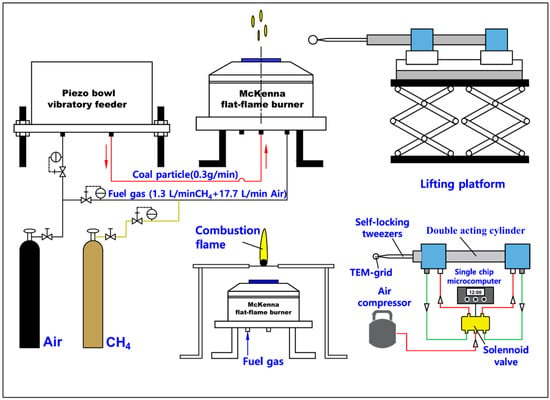
Figure 1.
Schematic depiction of the experimental apparatus.
2.2. Experimental Sampling Methodology
The thermophoresis sampling device is mainly composed of a pneumatic system, control circuit, sampling probe, and high-speed camera. The thermophoresis sampling device is installed on the electric translation platform to control the sampling height. The residence time of the TEM copper mesh in the flame is controlled by a single chip microcomputer. In order to confirm the position of the TEM copper mesh entering the flame and to ascertain the sampling time (residence time), a high-speed camera, FASTCAM Mini-UX50, was employed to document the complete thermophoresis sampling procedure [27], and the results are depicted in Figure 2. For stable simple hydrocarbon combustion flames, it is usually recommended that the thermophoresis sampling time for soot collection be approximately 23–65 ms [17]. However, for solid fuels such as coal, their combustion flames are chaotic and slender. Therefore, we have extended the thermophoresis sampling time to 100 ms in order to effectively collect soot samples for further morphology observation and analysis. Nascent soot and mature soot were collected to explore the effect of coal grain size on soot morphology during different combustion stages. The nascent soot was collected from the base of the combustion flame, while the mature soot was gathered from the middle and upper sections of the combustion flame.
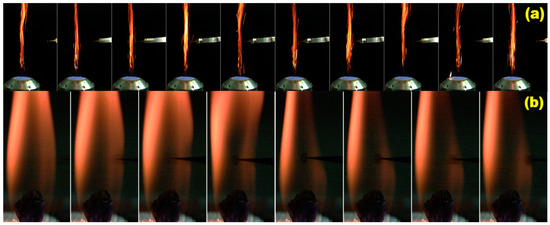
Figure 2.
Images of thermophoresis sampling captured using a high-speed camera: (a) sample #1; (b) sample #2.
2.3. Theoretical Analysis Method
The collected soot samples underwent examination and analysis utilizing a high-resolution transmission electron microscope (JEOL JEM-F200) (Japan electronics Co., Ltd., Tokyo, Japan) and a scanning electron microscope (Sigma 300) (German Zeiss Company, Oberkochen, Germany). Nascent soot samples were subjected to high-magnification transmission electron microscopy (TEM) analysis to investigate their nanocrystalline structure, while SEM analysis was conducted on mature soot samples to obtain the morphological parameters such as grain size, intergranular distance, fractal dimension, and pre-exponential factor. Based on the fractal theory [28], the fractal dimension and pre-exponential factor are calculated using a least squares linear fitting approach applied to N and L/Dp and yielding the following fitting formula:
where N denotes the count of nascent particles in each aggregate; L represents the maximum projection length; Dp is the average diameter of primary particle; KL represents the correlation factor, which can be calculated by Equation (2); and Df is the fractal dimension.
where Kf denotes the pre-exponential factor.
3. Results and Discussion
3.1. Influence of Grain Size on the Morphology of Nascent Soot
Figure 3 shows TEM pictures of nascent soot collected from the combustion flame roots of the two different grain sizes of coal. As shown in Figure 3, the nascent soot produced during the burning process of small-sized coal (sample #1) is composed of relatively uniform individual particles, whereas that produced in the combustion flame of large-sized coal (sample 2) is individual particles of uneven sizes. In addition, Figure 4 presents the statistical results of the grain size of nascent soot particles for further quantitative analysis. It can be observed that the grain size distribution of nascent soot produced by sample #1 is in the range of 8–14 nm, exhibiting an average grain size of 10.4 nm. In comparison, the nascent soot particles generated in the combustion flame of sample #2 are much larger than those generated in the combustion flame of sample #1. Furthermore, the size distribution range of soot in sample #2 is relatively wide, approximately 50–350 nm, with an average grain size of 123.9 nm.
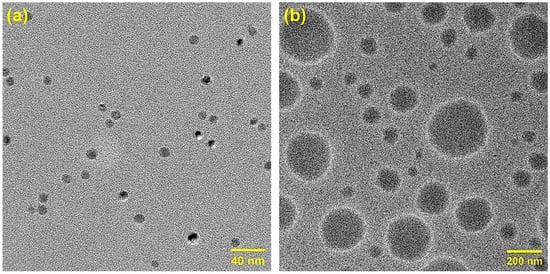
Figure 3.
TEM pictures of nascent soot: (a) sample #1; (b) sample #2.

Figure 4.
Primary grain size distribution: (a) sample #1; (b) sample #2.
The nascent particles of soot in the combustion flames of coal are mainly formed by the accumulation of volatiles released from coal. Xu et al. [29] comprehensively characterized the oxidative properties of soot and demonstrated that the liquid tar formed at the root of the flame is a precursor of soot particles, directly demonstrating that the majority of mature soot particles are derived from this liquid tar through carbonization, which indicated that the generation of soot in coal flames is closely associated with the volatiles in tar. Research has shown that the release rate of volatiles in coal is greatly influenced by grain size, with the release rate of small particles being higher than that of large particles [30]. In addition, the increase in the specific surface area of small-sized coal particles leads to early ignition, more intense combustion, and higher combustion temperatures [15]. The release rate of volatiles in the small-sized combustion flame of coal is faster, and the formation rate of nascent soot particles is faster. These formed nascent soot particles then undergo volatilization and oxidation reactions. Because the combustion flame temperature of small-sized coal is higher, the volatilization and oxidation rate are faster, resulting in the formation of soot particles with a smaller and more uniform grain size. The release rate of volatiles in large-sized coal is relatively slow, which leads to the fact that volatiles do not have a sufficient reaction time in the process of forming soot particles and, finally, generate larger soot particles.
3.2. Influence of Particle Size on the Microstructural Characteristics of Nascent Soot Particles
Figure 5 shows the HRTEM image of the nascent soot. It can be observed that the crystal structure is mainly composed of straight crystal stripes running parallel to each other. But the soot formed by sample #1 has an obvious crystalline stripe structure, while no obvious crystal structure was observed in sample #2. As shown in Figure 5d, only a small number of microcrystalline structures are found in soot particles formed by sample #2, and these microcrystalline structures mainly appear at the edge of particles. This is because the grain size of sample #2 is larger, the volatiles release is slower, and the combustion temperature is lower, resulting in an insufficient reaction of volatiles during the soot formation process. This makes the soot particles mostly incompletely reacted substances, and so no microcrystalline stripe structure was observed. This makes the formed soot particles mainly consist of incompletely reacted substances, so that the microcrystalline stripe structure is not observed. Furthermore, the intergranular distances between the crystal stripes in the two types of nascent soot particles were calculated. The intergranular distance of sample #1 (1.1 A) is smaller than that of sample #2 (1.5 A), signifying that the crystal structure of nascent soot particles produced in the combustion flame of coal became more condensed with the decrease in grain size.
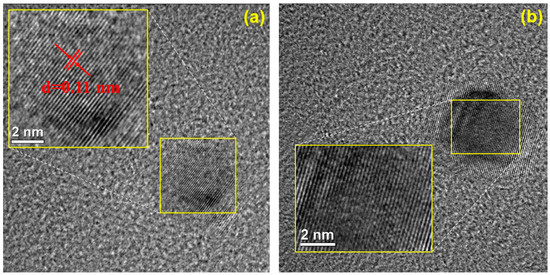
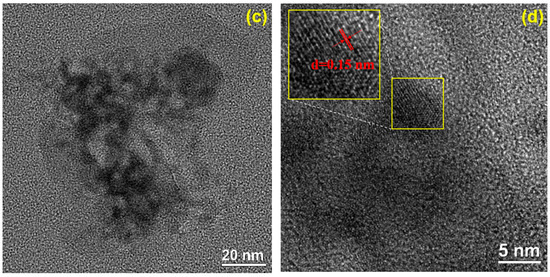
Figure 5.
HRTEM pictures of nascent soot particles: (a,b) sample #1; (c,d) sample #2.
3.3. Influence of Grain Size on the Morphology of Mature Soot Particles
Figure 6 illustrates the SEM image of mature soot particles taken by a scanning electron microscope. It can be seen that mature soot is mainly made of aggregates consisting of nearly spherical nascent particles, exhibiting a diverse range of sizes and quantities, and that both soot aggregates aggregate in a “grape” chain. By comparing Figure 6a,c, it can be observed that the total amount of soot formed by sample #1 is much less than that of sample #2. This is because the coal combusts more completely as the grain size decreases, so the generated soot is oxidized to a greater extent. Moreover, as shown in Figure 6, the aggregation degree of soot aggregates in sample #1 is relatively low, while that in sample #2 is relatively high. For further analysis, the fractal parameters of soot aggregates were also obtained through SEM image analysis and summarized in Figure 7. The results show that the fractal dimension of the two types of soot falls within the range of 1.5–2.0, which is congruent with the reported findings [31,32,33,34]. The fractal dimension of soot generated by sample #1 and sample #2 is 1.65 and 1.85, respectively, indicating that the mature soot formed by large-sized coal has better agglomeration and a more compact structure.
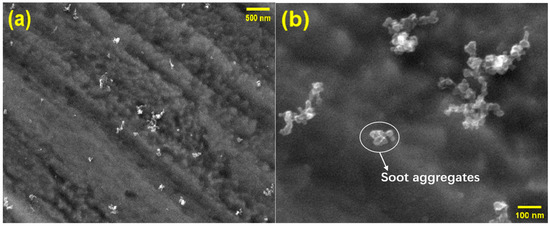
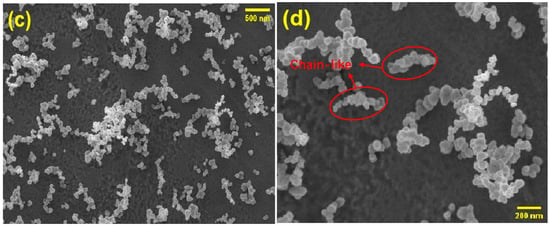
Figure 6.
SEM images of mature soot: (a,b) sample #1; (c,d) sample #2.
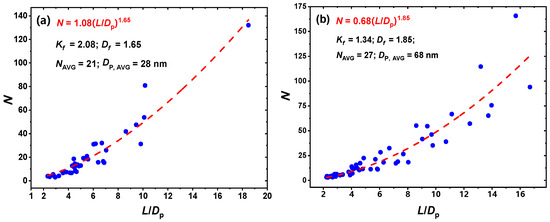
Figure 7.
Morphological parameter of soot: (a) sample #1; (b) sample #2.
The Image J software (Image J.Ink) was employed to calculate the average grain size of nascent particles within the two varieties of soot aggregates. It can be found that the nascent particles of soot formed by sample #1 increased from 10.4 nm to 28 nm, while the nascent particles of soot formed by sample #2 decreased from 123.9 nm to 68 nm. After the nascent particles of soot are generated by nucleation, the surface of these nascent particles undergoes oxidation and growth reactions simultaneously. These two reactions are competitive processes, and the results of their competition determine the size of the nascent soot particles [35]. In the combustion flame of small-sized coal, the surface growth reaction of soot particles plays a significant role in increasing the primary grain size of soot, which follows the general rule of the change in the primary grain size of soot in other hydrocarbon flames [36,37]. For the large-sized coal combustion flame, as analyzed in Section 2.1 and Section 2.2, there are more underreacted volatile substances inside the nascent soot particles. These substances are more likely to undergo splitting, volatilization, and oxidation reactions, which eventually lead to a continuous decrease in grain size. In addition, the quantity of nascent particles that presents the two types of soot aggregates was also counted. The number of nascent particles in soot formed by small-sized coal was 21, which was equivalent to that formed by large-sized coal (27). Characteristics of soot particles formed by coal on different grain sizes are statistically presented in Table 1.

Table 1.
Characteristics of soot particles.
3.4. Industrial Application
The filtration mechanism of soot filters varies for different grain sizes of soot particles. Smaller particles are captured primarily by diffusion, as they are more likely to come into contact with the filter media and be adsorbed due to their more pronounced Brownian motion in the air stream. Larger particles are filtered through interception and inertial impact. When designing soot filters, it is necessary to optimize the structure and pore size of the filter media according to the distribution of the main soot particles in order to improve the filtration efficiency for different particle sizes. It is obvious that when the soot particle size is as small as possible, the adsorption effect of the soot filter is also better. Therefore, minimizing the grain size of pulverized coal in combustion burners will help in the collection of soot.
4. Conclusions
This study conducted experimental research to explore the influence of coal particle size on the morphological parameters and nanostructure characteristics of soot generated in the combustion process. The soot samples were collected from two kinds of combustion flames used on coal by thermophoresis sampling techniques. Subsequently, the soot samples were examined and analyzed using a transmission electron microscope and scanning electron microscope, resulting in the determination of fractal morphological parameters and nanostructure characteristics.
TEM findings indicate that the nascent soot formed by the combustion of small-sized coal is composed of relatively uniform individual particles with a grain size of 8–14 nm, and its grain size is much smaller than that of soot formed by the combustion of large-sized coal (with a grain size range of 50–350 nm). The high-resolution transmission electron microscopy images indicate that the nanostructures of the nascent soot particles in both coal samples are composed of straight parallel crystal stripes. Furthermore, the crystal structure of soot formed by small-sized coal has an obvious microcrystalline structure, while the soot particles formed by large-sized coal only have a slight microcrystalline structure at the edge. In addition, the intergranular distance of soot formed by small-sized coal is smaller than that of the soot formed by large-sized coal, implying that the crystal structure of the formed soot particles is more compact with the decrease in the grain size.
SEM results show that the two mature soot particles predominantly comprise aggregates consisting of nascent particles with approximate spherical shapes, characterized by varying numbers and sizes, and that both soot aggregates aggregate in a “grape” chain. In comparison, the soot aggregates generated by large-sized coal have larger fractal dimensions, indicating heightened aggregation and a more condensed structure. The average diameter of nascent particles of soot aggregates formed by small-sized coal is measured to be about 28 nm, while that formed by large-sized coal is about 68 nm. Meanwhile, the quantity of nascent particles in soot aggregates produced during the combustion of two sizes of coal is equivalent.
Author Contributions
Conceptualization, M.S.; methodology, M.S.; software, J.L.; validation, Y.Z. and M.S.; formal analysis, J.L.; investigation, C.S.; data curation, J.L.; writing—original draft preparation, J.L.; writing—review and editing, M.S.; supervision, M.S. and B.L.; funding acquisition, M.S. and Y.Z. All authors have read and agreed to the published version of the manuscript.
Funding
This work was supported by the National Natural Science Foundation of China (Nos. 52206218, 52274060).
Data Availability Statement
The data that support the findings of this study are available within the article.
Conflicts of Interest
The authors declare no conflicts of interest.
Nomenclature
| HRTEM | High-resolution transmission electron microscopy; |
| SEM | Scanning electron microscope; |
| Kf | Pre-exponential factor; |
| Df | Fractal dimension. |
References
- Lin, B.; Ullah, S. Modeling the impacts of changes in nuclear energy, natural gas, and coal in the environment through the novel DARDL approach. Energy 2024, 287, 129572. [Google Scholar] [CrossRef]
- Fletcher, T.H.; Ma, J.; Rigby, J.R.; Brown, A.L.; Webb, B.W. Soot in coal combustion systems. Prog. Energy Combust. Sci. 1997, 23, 283–301. [Google Scholar] [CrossRef]
- Wang, Y.; Chung, S.H. Soot formation in laminar counterflow flames. Prog. Energy Combust. Sci. 2019, 74, 152–238. [Google Scholar] [CrossRef]
- Feng, D.; Shang, Q.; Dong, H.; Zhang, Y.; Wang, Z.; Li, D.; Xie, M.; Wei, Q.; Zhao, Y.; Sun, S. Catalytic mechanism of Na on coal pyrolysis-derived carbon black formation: Experiment and DFT simulation. Fuel Process. Technol. 2021, 224, 107011. [Google Scholar] [CrossRef]
- Linak, W.P.; Yoo, J.I.; Wasson, S.J.; Zhu, W.; Wendt, J.O.; Huggins, F.E.; Chen, Y.; Shah, N.; Huffman, G.P.; Gilmour, M.I. Ultrafine ash aerosols from coal combustion: Characterization and health effects. Proc. Combust. Inst. 2007, 31, 1929–1937. [Google Scholar] [CrossRef]
- Duan, S.; Zhang, M.; Sun, Y.; Fang, Z.; Wang, H.; Li, S.; Peng, Y.; Li, J.; Li, J.; Tian, J.; et al. Mechanism of PM2. 5-induced human bronchial epithelial cell toxicity in central China. J. Hazard. Mater. 2020, 396, 122747. [Google Scholar] [CrossRef]
- Liu, X.; Xu, Y.; Qi, J.; Wang, H.; Zhang, T.; Xu, M. Effects of kaolin-limestone blended additive on the formation and emission of particulate matter: Field study on a 1000 MW coal-firing power station. J. Hazard. Mater. 2020, 399, 123091. [Google Scholar] [CrossRef] [PubMed]
- Im, K.; Ahluwalia, R.K. Radiation properties of coal combustion products. Int. J. Heat Mass Transf. 1993, 36, 293–302. [Google Scholar] [CrossRef]
- Wen, W.-Y. Mechanisms of Alkali Metal Catalysis in the Gasification of Coal, Char, or Graphite. Catal. Rev. 1980, 22, 1–28. [Google Scholar] [CrossRef]
- Trubetskaya, A.; Jensen, P.A.; Jensen, A.D.; Garcia Llamas, A.D.; Umeki, K.; Gardini, D.; Kling, J.; Bates, R.B.; Glarborg, P. Effects of several types of biomass fuels on the yield, nanostructure and reactivity of soot from fast pyrolysis at high temperatures. Appl. Energy 2016, 171, 468–482. [Google Scholar] [CrossRef]
- Wang, X.; Bai, S.; Jin, Q.; Li, S.; Li, Y.; Li, Y.; Tan, H. Soot formation during biomass pyrolysis: Effects of temperature, water-leaching, and gas-phase residence time. J. Anal. Appl. Pyrolysis 2018, 134, 484–494. [Google Scholar] [CrossRef]
- Han, Y.; Chen, Y.; Feng, Y.; Song, W.; Cao, F.; Zhang, Y.; Li, Q.; Yang, X.; Chen, J. Different formation mechanisms of PAH during wood and coal combustion under different temperatures. Atmos. Environ. 2020, 222, 117084. [Google Scholar] [CrossRef]
- Jiang, X.; Zheng, C.; Yan, C.; Liu, D.; Qiu, J.; Li, J. Physical structure and combustion properties of super fine pulverized coal particle. Fuel 2002, 81, 793–797. [Google Scholar] [CrossRef]
- Zhang, J.; Ye, L.; Ren, K.; Xu, R.; Teng, Z.; Zhu, J. Kinetic and experimental analysis of the effect of particle size on combustion performance of low-rank coals. Fuel 2023, 349, 128675. [Google Scholar] [CrossRef]
- Cong, K.; Zhang, Y.; Han, F.; Li, Q. Influence of particle sizes on combustion characteristics of coal particles in oxygen-deficient atmosphere. Energy 2019, 170, 840–848. [Google Scholar] [CrossRef]
- Yan, X.Z.; Chen, D.L.; Liu, L.; Wang, X.W. Experimental investigation of the influence of coal powder fineness on combustion characteristics. J. Power Eng. 2007, 27, 684–686. [Google Scholar]
- Liu, H.; Wu, S.H.; Zhao, G.B.; Qiu, P.H.; Qin, Y.K. Influence of coal particle size on the combustion characteristics of yuanbaoshan lignite. J. Harbin Inst. Technol. 2008, 112, 11357–11362. [Google Scholar]
- Yang, Y.; Liu, J.; Jin, S.; Li, T. Experimental study about influence of particle size and oxygen atmosphere on straw powder’s combustion characteristics. In Proceedings of the 2011 International Conference on Electrical and Control Engineering, Yichang, China, 16–18 September 2011. [Google Scholar]
- Yi, B.; Zhang, L.; Mao, Z.; Huang, F.; Zheng, C. Effect of the particle size on combustion characteristics of pulverized coal in an O2/CO2 atmosphere. Fuel Process. Technol. 2014, 128, 17–27. [Google Scholar] [CrossRef]
- Guo, Z.; Lou, C.; Liu, Z.; Zhou, H. The impact of combustion characteristics and flame structure on soot formation in oxy-enhanced and oxy-fuel diffusion flames. Sci. China Technol. Sci. 2013, 56, 1618–1628. [Google Scholar] [CrossRef]
- Du, J.; Axelbaum, R.L. The effect of flame structure on soot-particle inception in diffusion flames. Combust. Flame 1995, 100, 367–375. [Google Scholar] [CrossRef]
- Ma, J.; Fletcher, T.H.; Webb, B.W. Conversion of coal tar to soot during coal pyrolysis in a post-flame environment. Symp. (Int.) Combust. 1996, 26, 3161–3167. [Google Scholar] [CrossRef]
- Moghiman, M.; Gruenberger, T.M.J. Experimental and computational studies of soot emission in a gas fuelled swirl stabilized combustor. Iran. J. Sci. Technol. 2013, 26, 541–554. [Google Scholar]
- Lou, C.; Li, Z.; Zhang, Y.; Kumfer, B.M. Soot formation characteristics in laminar coflow flames with application to oxy-combustion. Combust. Flame 2021, 227, 371–383. [Google Scholar] [CrossRef]
- Sadeq, A.M. Combustion Advancements: From Molecules to Future Challenges; Independently published: Chicago, IL, USA, 2023. [Google Scholar]
- Si, M.; Cheng, Q.; Zhang, Q.; Wang, D.; Luo, Z.; Lou, C. Study of temperature, apparent spectral emissivity, and soot loading of a single burning coal particle using hyper-spectral imaging technique. Combust. Flame 2019, 209, 267–277. [Google Scholar] [CrossRef]
- Si, M.; Cheng, Q.; Yuan, L.; Luo, Z. High Temporal–spatial Distribution of Soot Temperature and Volume Fraction in Single Coal Combustion Flame. Combust. Sci. Technol. 2022, 194, 3246–3258. [Google Scholar] [CrossRef]
- Köylü, Ü.Ö.; McEnally, C.S.; Rosner, D.E.; Pfefferle, L.D. Simultaneous measurements of soot volume fraction and particle size/microstructure in flames using a thermophoretic sampling technique. Combust. Flame 1997, 110, 494–507. [Google Scholar] [CrossRef]
- Xu, Y.; Zhu, J.; Liu, X.; Qi, J.; Wang, H.; Cheng, X.; Xu, J. Insight into soot formed in coal combustion flame: Evolution of physiochemical structure, oxidation reactivity. Fuel 2022, 312, 122948. [Google Scholar] [CrossRef]
- Saha, M.; Dally, B.B.; Medwell, P.R.; Chinnici, A. Effect of particle size on the MILD combustion characteristics of pulverised brown coal. Fuel Process. Technol. 2017, 155, 74–87. [Google Scholar] [CrossRef]
- Koeylue, U.; Xing, Y.; Rosner, D.E. Fractal Morphology Analysis of Combustion-Generated Aggregates Using Angular Light Scattering and Electron Microscope Images. Langmuir 2002, 11, 4848–4854. [Google Scholar] [CrossRef]
- Wentzel, M.; Gorzawski, H.; Naumann, K.H.; Saathoff, H.; Weinbruch, S. Transmission electron microscopical and aerosol dynamical characterization of soot aerosols. J. Aerosol Sci. 2003, 34, 1347–1370. [Google Scholar] [CrossRef]
- Köylü, Ü.Ö.; Faeth, G.M.; Farias, T.L.; Carvalho, M.G. Fractal and projected structure properties of soot aggregates. Combust. Flame 1995, 100, 621–633. [Google Scholar] [CrossRef]
- Gwaze, P.; Schmid, O.; Annegarn, H.J.; Andreae, M.O.; Huth, J.; Helas, G. Comparison of three methods of fractal analysis applied to soot aggregates from wood combustion. J. Aerosol Sci. 2006, 37, 820–838. [Google Scholar] [CrossRef]
- Yu, J.; Chen, L.; Zhang, J.; Wu, J.; Wu, X.; Zeng, Q.; Cen, K. Influences of Coal Type and Particle Size on Soot Measurement by Laser-Induced Incandescence and Soot Formation Characteristics in Laminar Pulverized Coal Flames. Energy Fuels 2020, 34, 13740–13749. [Google Scholar] [CrossRef]
- Harris, S.J.; Weiner, A.M. Chemical Kinetics of Soot Particle Growth. Annu. Rev. Phys. Chem. 1985, 36, 31–52. [Google Scholar] [CrossRef]
- Hagen, F.P.; Vlavakis, P.; Bockhorn, H.; Suntz, R.; Trimis, D. From molecular to sub-μm scale: The interplay of precursor concentrations, primary particle size, and carbon nanostructure during soot formation in counter-flow diffusion flames. Combust. Flame 2023, 258, 112729. [Google Scholar] [CrossRef]
Disclaimer/Publisher’s Note: The statements, opinions and data contained in all publications are solely those of the individual author(s) and contributor(s) and not of MDPI and/or the editor(s). MDPI and/or the editor(s) disclaim responsibility for any injury to people or property resulting from any ideas, methods, instructions or products referred to in the content. |
© 2024 by the authors. Licensee MDPI, Basel, Switzerland. This article is an open access article distributed under the terms and conditions of the Creative Commons Attribution (CC BY) license (https://creativecommons.org/licenses/by/4.0/).